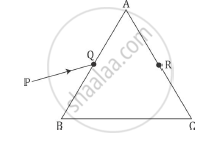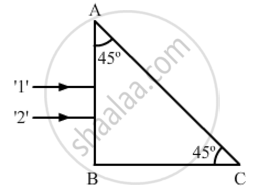Advertisements
Advertisements
Question
A ray of light is incident on a prism whose refractive index is 1.52 at an angle of 40°. If the angle of emergence is 60°, calculate the angle of the prism.
Solution
Given :
`mu = 1.52` `i = 40^circ`
`e = 60^circ` A = ?
`mu = sin i/sin r`
`1.52 = sin 40^circ/sin r`
`therefore sin r = 0.6427/1.52`
`sin r = 0.4228`
`therefore r = sin^-1(0.4228)`
`r = 25.01^circ`
`1/mu = (sin r')/sin e ⇒ sin r' = sin e/mu`
⇒ `sin r' = sin 60^circ/1.52 = 0.866/1.52 = 0.57`
⇒ `r' = sin^-1(0.57) = 34.75^circ`
`therefore A = r + r' = 25.01^circ + 34.75^circ = 59.76^circ`
APPEARS IN
RELATED QUESTIONS
A ray PQ incident on the face AB of a prism ABC, as shown in the figure, emerges from the face AC such that AQ = AR.

Draw the ray diagram showing the passage of the ray through the prism. If the angle of the prism is 60° and refractive index of the material of prism is `sqrt3` , determine the values of angle of incidence and angle of deviation
Two monochromatic rays of light are incident normally on the face AB of an isosceles right-angled prism ABC. The refractive indices of the glass prism for the two rays '1' and '2' are respectively 1.38 and 1.52. Trace the path of these rays after entering through the prism.

For any prism, prove that :
'n' or `mu = sin((A + delta_m)/2)/sin(A/2)`
where the terms have their usual meaning
Draw the ray diagram showing refraction of light through a glass prism and hence obtain the relation between the refractive index μ of the prism, angle of prism and angle of minimum deviation.
Give the formula that can be used to determine refractive index of materials of a prism in minimum deviation condition ?
The minimum deviations suffered by, yellow and violet beams passing through an equilateral transparent prism are 38.4°, 38.7° and 39.2° respectively. Calculate the dispersive power of the medium.
A thin prism of angle 6.0°, ω = 0.07 and μy = 1.50 is combined with another thin prism having ω = 0.08 and μy = 1.60. The combination produces no deviation in the mean ray. (a) Find the angle of the second prism. (b) Find the net angular dispersion produced by the combination when a beam of white light passes through it. (c) If the prisms are similarly directed, what will be the deviation in the mean ray? (d) Find the angular dispersion in the situation described in (c).
The refractive index of a material M1 changes by 0.014 and that of another material M2 changes by 0.024 as the colour of the light is changed from red to violet. Two thin prisms, one made of M1(A = 5.3°) and the other made of M2(A = 3.7°) are combined with their refracting angles oppositely directed. (a) Find the angular dispersion produced by the combination. (b) The prisms are now combined with their refracting angles similarly directed. Find the angular dispersion produced by the combination.
Define angular dispersion.
What is meant by a thin prism?
